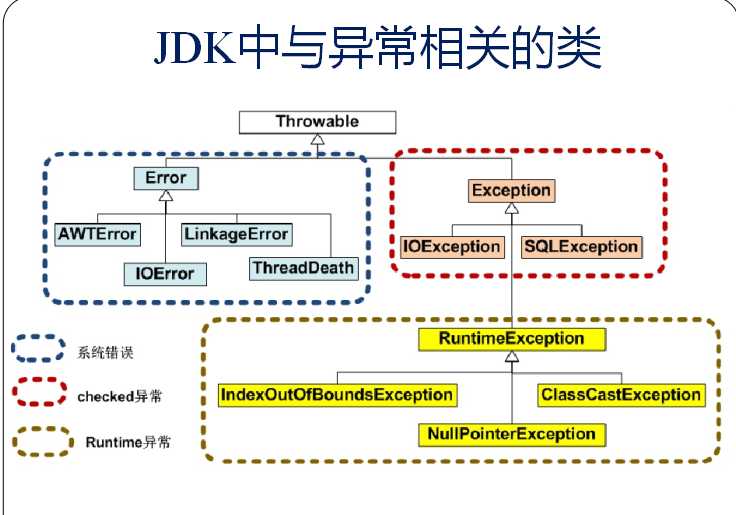标签:异常类方法 多个 try cal ble cep 代码 font mem
异常处理:try-catch-finally,throw,assert,异常类,方法。
1
try{
//可能出现异常的代码
}
Catch(异常类 异常对象){
//捕捉异常
//处理异常的代码
//异常类方法
printStackTrace();//打印方法调用堆栈

getMessage();返回异常相关信息
}
//可以有多个捕捉块,但异常类是Exception时不能有其子类异常捕捉
Catch(){
}
……
Finally{
//最终执行的代码,也是一定执行的代码
//但不一定要执行finally语句(我这有2种情况):如例3
//finall中语句也可能出错,那时将放弃先前的异常
}
//在结束时
//自动释放资源,close()自动调用
*Java多层嵌套异常处理流程*
2

3
处理方式
Catch捕捉(exception),
Throw:语句,抛出异常对象(exception)
throw语句抛出受控的异常,可抛出多个异常-捉到一个就可以。
继承中:在子类中throw语句抛出的异常类不能是父类中throw舆抛出的异常类的父类。
Assert语句,可在判断条件时,抛出系统错误(error)。
4特别的错误(error)-OOM(OutOfMemoryError)
内存不足
5实验
例1:
public class ExceptionT {
public static void main(String[] args) {
try {
int i=2;
int j=0;
int k=i/j;
System.out.println("k="+k);
}catch(Exception e) {
System.out.println("error1");
}
try {
double i=2;
double j=0;
double k=i/j;//不报错
System.out.println("k="+k);//k=Infinity;
//两处JVM生成的字节码不一样
}catch(Exception e) {
System.out.println("error2");
}
}
例2:
public class ExceptionT {
public static void main(String[] args) {
try {
int i=2;
int j=0;
int k=i/j;
System.out.println("k="+k);
}catch(Exception e) {
System.out.println("error1");
}finally{
int i1=2;
int i2=0;
System.out.println("k="+i1/i2);//出错
}
}
}

例3:多层捕获异常
Text1:
public class CatchWho {
public static void main(String[] args) {
try {
try {
throw new ArrayIndexOutOfBoundsException("error1");
}
catch(ArrayIndexOutOfBoundsException e) {
System.out.println( "ArrayIndexOutOfBoundsException" + "/内层try-catch");
}
throw new ArithmeticException("error2");
}
catch(ArithmeticException e) {
System.out.println("发生ArithmeticException");
}
catch(ArrayIndexOutOfBoundsException e) {
System.out.println( "ArrayIndexOutOfBoundsException" + "/外层try-catch");
}
}
}
Text2
public class CatchWho2 {
public static void main(String[] args) {
try {
try {
throw new ArrayIndexOutOfBoundsException("error1");
}
catch(ArithmeticException e) {
System.out.println( "ArrayIndexOutOfBoundsException" + "/内层try-catch");
}
throw new ArithmeticException("error2");
}
catch(ArithmeticException e) {
System.out.println("发生ArithmeticException");
}
catch(ArrayIndexOutOfBoundsException e) {
System.out.println( "ArrayIndexOutOfBoundsException" + "/外层try-catch");
}
}
}
Text3
public class EmbededFinally {
public static void main(String args[]) {
int result;
try {
System.out.println("in Level 1");
try {
System.out.println("in Level 2");
// result=100/0; //Level 2
try {
System.out.println("in Level 3");
result=100/0; //Level 3
}
catch (Exception e) {
System.out.println("Level 3:" + e.getClass().toString());
}
finally {
System.out.println("In Level 3 finally");
}
// result=100/0; //Level 2
}
catch (Exception e) {
System.out.println("Level 2:" + e.getClass().toString());
}
finally {
System.out.println("In Level 2 finally");
}
//result = 100 / 0; //level 1
}
catch (Exception e) {
System.out.println("Level 1:" + e.getClass().toString());
}
finally {
System.out.println("In Level 1 finally");
}
}
}
多层嵌套try-catch-finally
(1) 捕捉异常对象与抛出的异常类型相同,
(2) 有抛出异常时,先接受,结束程序
(3) finally语句不一定调用,有时在嵌套的外层出现异常并捕捉后内层的try-catch-finally就不执行了。
第二中是System.exit(0);程序终止语句出现。
实验:
import java.util.Scanner;
public class MyException {
public static void main(String args[]) {
System.out.println("输入你的成绩:");
Scanner scan=new Scanner(System.in);
try{
int score=scan.nextInt();
if(score<90) {
if(score<80) {
if(score<70) {
if(score<60) {
System.out.println("成绩不及格");
}
System.out.println("成绩及格");
}
System.out.println("成绩中");
}
System.out.println("成绩良");
}
System.out.println("成绩优");
}catch(Exception e) {
System.out.println("输入错误。输入一个整数。");
}
}
}

标签:异常类方法 多个 try cal ble cep 代码 font mem
原文地址:http://www.cnblogs.com/floakss/p/7859576.html